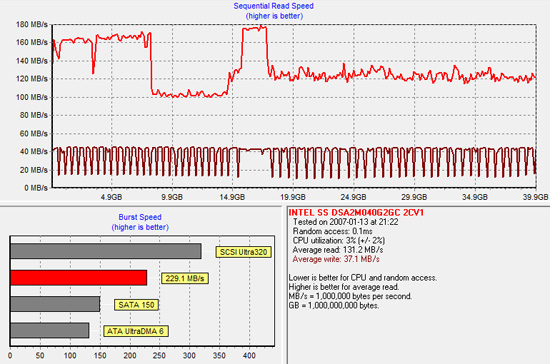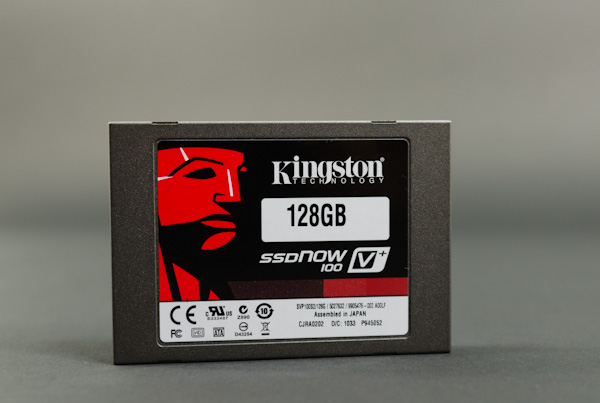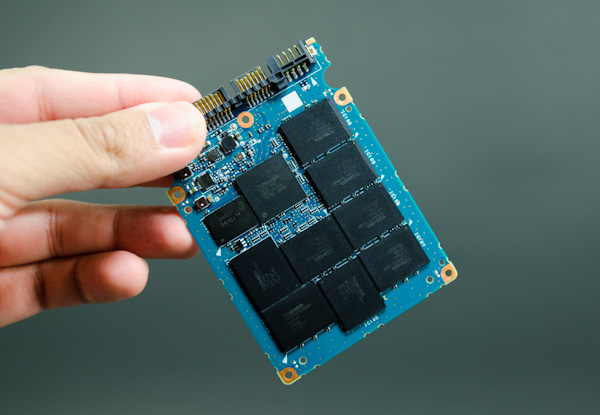Kingston SSDNow V+100 Review
by Anand Lal Shimpi on November 11, 2010 3:05 AM EST- Posted in
- Storage
- SSDs
- Kingston
- SSDNow V+100
I'm not sure what it is about SSD manufacturers and overly complicated product stacks. Kingston has no less than six different SSD brands in its lineup. The E Series, M Series, SSDNow V 100, SSDNow V+ 100, SSDNow V+ 100E and SSDNow V+ 180. The E and M series are just rebranded Intel drives, these use Intel's X25-E and X25-M G2 controllers respectively with Kingston logo on the enclosure. The SSDNow V 100 is an update to the SSDNow V Series drives, both of which use the JMicron JMF618 controller. Don't get this confused with the 30GB SSDNow V Series Boot Drive which actually uses a Toshiba T6UG1XBG controller, also used in the SSDNow V+. Confused yet? It gets better.
The standard V+ is gone and replaced by the new V+ 100, which is what we're here to take a look at today. This drive uses the T6UG1XBG controller but with updated firmware. The new firmware enables two things: very aggressive OS-independent garbage collection and higher overall performance. The former is very important as this is the same controller used in Apple's new MacBook Air. In fact, the performance of the Kingston V+100 drive mimics that of Apple's new SSDs:
| Apple vs. Kingston SSDNow V+100 Performance | ||||||
| Drive | Sequential Write | Sequential Read | Random Write | Random Read | ||
| Apple TS064C 64GB | 185.4 MB/s | 199.7 MB/s | 4.9 MB/s | 19.0 MB/s | ||
| Kingston SSDNow V+100 128GB | 193.1 MB/s | 227.0 MB/s | 4.9 MB/s | 19.7 MB/s | ||
Sequential speed is higher on the Kingston drive but that is likely due to the size difference. Random read/write speed are nearly identical. And there's one phrase in Kingston's press release that sums up why Apple chose this controller for its MacBook Air: "always-on garbage collection". Remember that NAND is written to at the page level (4KB), but erased at the block level (512 pages). Unless told otherwise, SSDs try to retain data as long as possible because to erase a block of NAND usually means erasing a bunch of valid as well as invalid data and then re-writing the valid data again to a new block. Garbage collection is the process by which a block of NAND is cleaned for future writes.

Diagram inspired by IBM Zurich Research Laboratory
If you're too lax with your garbage collection algorithm then write speed will eventually suffer. Each write will eventually have a large penalty associated with it, driving write latency up and throughput down. Too aggressive with garbage collection and drive lifespan suffers. NAND can only be written/erased a finite number of times, aggressively cleaning NAND before it's absolutely necessary will keep write performance high at the expense of wearing out NAND quicker.
Intel was the first to really show us what realtime garbage collection looked like. Here is a graph showing sequential write speed of Intel's X25-V:

The almost periodic square wave formed by the darker red line above shows a horribly fragmented X25-V attempting to clean itself up at every write. Eventually, with enough writes, the X25-V will return to peak performance. At every write request the X25-V controller will attempt to clean some blocks and return to peak performance. The garbage collection isn't seamless but it will eventually restore performance.
Now look at Kingston's SSDNow V+100, both before fragmentation and after:


There's hardly any difference. Actually the best way to see this in work is to look at power draw when firing random write requests all over the drive. The SSDNow V+100 has wild swings in power consumption during our random write test ranging from 1.25W to 3.40W. The swings would happen several times in a window of a couple of seconds. The V+100 is aggressively tries to reorganize writes and recycle bad blocks, more aggressively than we've seen from any other SSD.
The benefit of this is you get peak performance out of the drive regardless of how much you use it, which is perfect for an OS without TRIM support - ahem, OS X. Now you can see why Apple chose this controller.
There is a downside however: write amplification. For every 4KB we randomly write to a location on the drive, the actual amount of data written is much, much greater. It's the cost of constantly cleaning/reorganizing the drive for performance. While I haven't had any 50nm, 4xnm or 3xnm NAND physically wear out on me, the V+100 is the most likely to blow through those program/erase cycles. Keep in mind that at the 3xnm node you no longer have 10,000 cycles, but closer to 5,000 before your NAND dies. On nearly all drives we've tested this isn't an issue, but I would be concerned about the V+100. Concerned enough to recommend running it with 20% free space at all times (at least). The more free space you have, the better job the controller can do wear leveling.












96 Comments
View All Comments
eckre - Saturday, November 13, 2010 - link
So this seems like a perfect drive for a RAID because of it's aggressive always on garbage collection would make up for lack of TRIM support. ?Am I correct? Thoughts?
JohnWPB - Saturday, November 13, 2010 - link
I have built probably 10 pc's in the last 2 yrs, and wonder if adding a SSD as a boot drive would be worth the effort.I see you guys making lots of comments, but as a newbie on SSD's, I would really like to see a thread on how to introduce a SSD to a system that has a bunch of SATA drives.
Exactly how does one go about installing Windows XP Pro? I imagine that I should disconnect my SATA drives and just hook up the SSD and then do a CD install?
Can programs like CasperXP ( mirror imaging program ), be used to do a mirror image backup from an SSD to a Sata drive ( C: boot drive SSD to D: mirror drive SATA ).
My apologies if this was posted in the wrong thread.
Out of Box Experience - Saturday, November 20, 2010 - link
QUOTE:Exactly how does one go about installing Windows XP Pro? I imagine that I should disconnect my SATA drives and just hook up the SSD and then do a CD install?
---------------------------------------------------------------------------------------------------------
You are correct as far as I can tell...
I just spent the past 2 days retesting the copy/paste speed of a Vertex 2 with the alignment tweak recommended by OCZ
There was no speed benefit resulting from the alignment of the partition as OCZ described
Copy and paste speed was still a miserable 3.6 megabutes per second
But just to be on the safe side, I will start using ONLY Intel SSD's with Windows XP
Anand says Intel controllers are alignment agnostic and should be the best for non-compressible data under XP
So, untill other SSD manufacturers start making alignment agnostic controllers that are capeable of doing a copy and paste faster than my 5400RPM laptop drive under XP, I think I'll just stick with Intel
(Better Flash Quality as well)
Ezekeel - Saturday, November 13, 2010 - link
Hi Anand,you noted that due to the aggressive garbage-collection this SSD will have a large write-amplification, so the flash will wear-out more quickly. What would happen when using this SSD with an OS that supports TRIM? Will TRIM support the internal GC and lead to a smaller write-amplification and thus a longer lifetime of the SSD?
mpx - Sunday, November 14, 2010 - link
Can you test how VMs behave on SSD? I understand it's partially there in synthetic IOPS and bandwith tests - that show what can you get max. from these drives. But "normal" load from multiple VMs should be different than normal load from a single OS, so drives that do good at normal load in current test migth be not performant under normal load of multiple VMs.This test with few VMs makes sense for larger drives (160, 256GB), as there just won't be enough place for multiple OSes on small drives. Also longevity becomes more important when you have few times larger load.
tecknurd - Sunday, November 14, 2010 - link
I use Linux and its TRIM command support is sparse. Finally a drive that does not require the TRIM command. I know it comes at a cost of more wear and tear, but I do not mind because pros out weighs the cons. It will give me no noise from the storage system and it be about 60 times quicker than my hard drive to access files. I do not think $280 for 128 GB is not a bad deal for a SSD that does not require the TRIM command to function great. Though, one thing that comes to mind is does the Kingston SSDNow V+100 come with ECC because all hard drives includes ECC for data integrity.Ezekeel - Sunday, November 14, 2010 - link
Why sparse? The kernel supports TRIM since 2.6.33 (early 2010).tecknurd - Wednesday, November 17, 2010 - link
True, but the file system also have problems with SSD. Not all file system in Linux are SSD aware. EXT3 and EXT4 does not have good support to handle SSD.Ezekeel - Friday, November 19, 2010 - link
Linux filesystems ext3/ext4 are designed for magnetic drives - but that is also true for ntfs and hfs+, so the problems with SSD are not unique to Linux. However, it is true that while at least Windows7 does some automatic optimizations, you have to configure everything manually under Linux.sprockkets - Sunday, November 21, 2010 - link
All you have to do is format the drive with ext4, add the discard option, and you are set. TRIM is enabled automatically in the background; no need to manually run the command anymore.Even with the latest firmwares, this isn't an issue anyway.